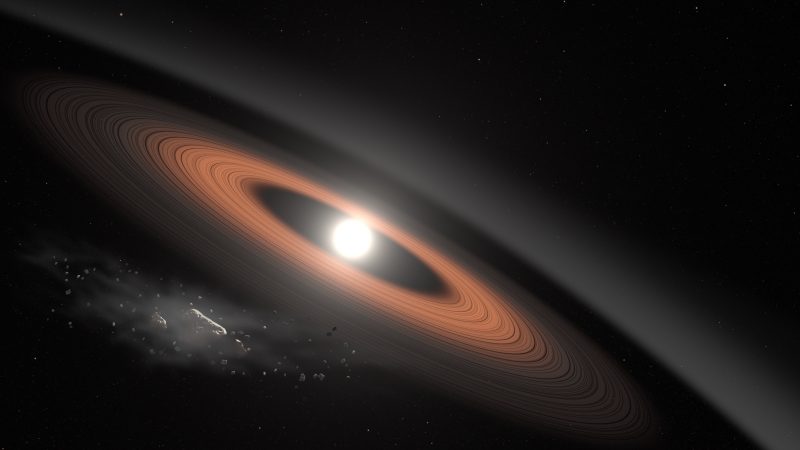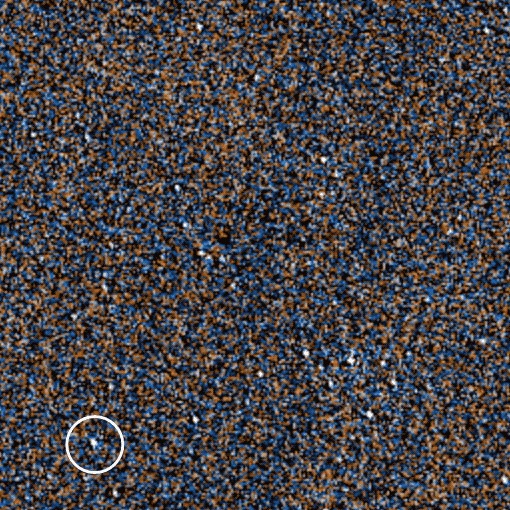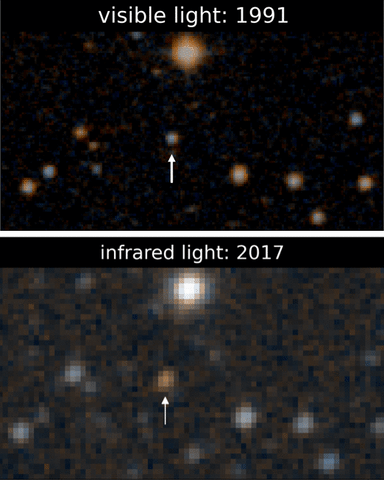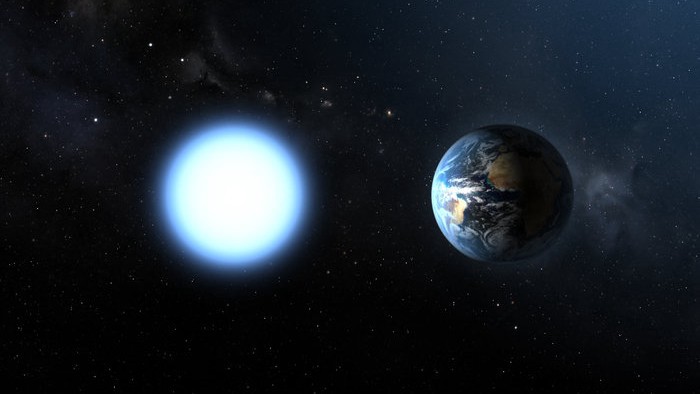
Help EarthSky keep going! Please donate what you can to our annual crowd-funding campaign.
Rings are a common phenomenon in our universe. In recent decades, we’ve learned that gas and ice giant planets can have rings; in our solar system, Jupiter, Saturn, Uranus and Neptune all have them. Even some asteroids are now known to have their own ring systems. Stars – especially young stars in the process of making their own solar systems – have rings. And even some white dwarf stars – which are small, dense stars in an advanced stage of their evolution – are known to have rings. They’re typically found for young white dwarfs. Now – thanks to the help of a citizen scientist – multiple rings have been found for a much older white dwarf. Astronomers say these rings are a real puzzle!
Astronomers announced this finding in a peer-reviewed paper published in the February 19, 2019, issue of The Astrophysical Journal Letters.
A citizen scientist – Melina Thévenot – made the discovery. She’s a volunteer with the NASA-led Backyard Worlds: Planet 9 project. The white dwarf star is labeled LSPM J0207+3331. It’s about 145 light-years away in the direction of our constellation Capricornus the Sea Goat. In 2014, J0207 was found to be the oldest and coldest known white dwarf yet. It’s an Earth-sized core remnant of a once-sunlike star that has died.
According to John Debes, an astronomer at the Space Telescope Science Institute in Baltimore:
This white dwarf is so old that whatever process is feeding material into its rings must operate on billion-year timescales. Most of the models scientists have created to explain rings around white dwarfs only work well up to around 100 million years …

Citizen scientists working on Backyard Worlds: Planet 9 scrutinize “flipbooks” of images from NASA’s Wide-field Infrared Survey Explorer. This animation shows a flipbook containing the ring-bearing white dwarf LSPM J0207+3331 (circled).
Image via Backyard Worlds: Planet 9/NASA.
J0207 is estimated to be three billion years old. That estimate is based on its temperature of just over 10,500 degrees Fahrenheit (5,800 degrees Celsius). The presence of dust around J0207 became evident in data from NASA’s Wide-field Infrared Survey Explorer (WISE) mission.
Now J0207 is not only the oldest and coldest white dwarf known; it’s also the oldest and coldest white dwarf with a ring system.
Citizen scientist Thévenot made the discovery while searching through the European Space Agency’s (ESA’s) Gaia archives for brown dwarfs – objects too large to be planets but too small to be stars. In other words, as so often happens in science, she wasn’t looking for white dwarf rings; she was looking for something else.
After noticing an object that might be a brown dwarf, she then looked at the object in WISE’s infrared data. That way of looking showed the object was too bright and too distant to be a brown dwarf. She passed on the findings to the Backyard Worlds: Planet 9 team, and Adam Burgasser at the University of California, San Diego was asked to conduct follow-up observations with the Keck II telescope at the W. M. Keck Observatory in Hawaii.
The Keck observations confirmed the earlier ones. As noted by Thévenot:
That is a really motivating aspect of the search. The researchers will move their telescopes to look at worlds you have discovered. What I especially enjoy, though, is the interaction with the awesome research team. Everyone is very kind, and they are always trying to make the best out of our discoveries.

So how did this very old and cold white dwarf – LSPM J0207+3331 – get its rings? Scientists aren’t sure yet, but the answer likely has to do with the stuff left in orbit around the white dwarfs, even after the star has entered the white dwarf stage. In other words, white dwarf stars were once ordinary stars like our sun. Some likely had their own solar systems. NASA explained:
… some white dwarfs — between one and four percent — show infrared emission indicating they’re surrounded by dusty disks or rings. Scientists think the dust may arise from distant asteroids and comets kicked closer to the star by gravitational interactions with displaced planets. As these small bodies approach the white dwarf, the star’s strong gravity tears them apart in a process called tidal disruption.
The debris forms a ring of dust that will slowly spiral down onto the surface of the star.
Older white dwarfs are thought to be less likely to have rings, since – the longer time passes for any given white dwarf system – the more interactions will have already occurred, leaving less material in orbit to provide dust for the rings. Debes compared the process to grains of sand falling through an hourglass. Eventually, all the grains in the top of the hourglass will become depleted.
Yet J0207 is known to be an old white dwarf, and it does have rings. It’s thought the star may have multiple rings, not just one. Astronomers say there may be a thin ring at the point where the star’s gravitational tides break up the asteroids, and a wider ring closer to the white dwarf star itself.
It’s a puzzle!

By the way, Backyard Worlds: Planet 9 currently has over 150,000 volunteer citizen scientists. As explained by Marc Kuchner, a co-author of the paper and astrophysicist at Goddard Space Flight Center:
We built Backyard Worlds: Planet 9 mostly to search for brown dwarfs and new planets in the solar system. But working with citizen scientists always leads to surprises. They are voracious – the project just celebrated its second birthday, and they’ve already discovered more than 1,000 likely brown dwarfs. Now that we’ve rebooted the website with double the amount of WISE data, we’re looking forward to even more exciting discoveries.
Bottom line: Thanks to a citizen scientist, astronomers have now found the oldest and coldest white dwarf star known to have rings.











